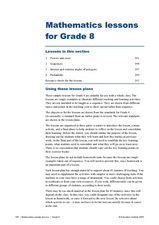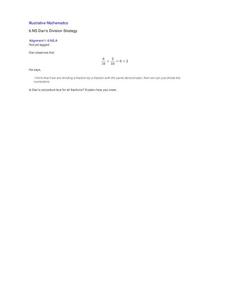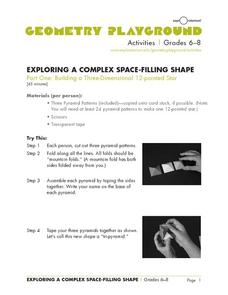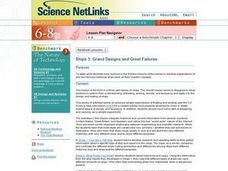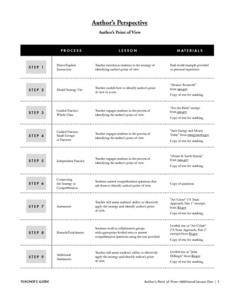Illustrative Mathematics
Molly's Run
A simple lesson with a lot of support behind it. Your learners will find out how long it takes Molly to run a mile by choosing their solution method. The activity can be used as a lesson or as an independent assignment. Preface with...
Illustrative Mathematics
Drinking Juice, Variation 3
It is up to the learner to find the amount of juice originally in a bottle, knowing what fraction of the juice is left, and the amount that has been consumed. The accompanying commentary provides a useful and detailed description of...
Curated OER
Quinoa Pasta 3
A mixture of quinoa and corn is for dinner in this collaborative task that sets up nicely as a system of linear equations. Your supper guests discuss numerical precision and percentages as they formulate a plan of how to solve the problem.
Curated OER
Powers and Roots
Eighth graders determine the square and cube roots of given numbers in this math instructional activity. They determine the missing number in a sequence. Additionally, they calculate the interior and exterior polygon angles.
Illustrative Mathematics
Dan’s Division Strategy
Can Dan make a conjecture about dividing fractions with the same denominators? That is what your scholars are to determine. They must show that if the statement is true, they understand how the quantities were determined, and how...
Chicago Botanic Garden
Weather or Not
What is the difference between weather and climate? This is the focus question of a lesson that takes a deeper look at how weather data helps determine climate in a region. Using weather and climate cards, young scholars decide...
Curated OER
The Greedy Dog
Teach young mathematicians the concepts of greater than, less than, and equal to with kinesthetic, visual, verbal, and numeric approaches. In a playful session that addresses multiple intelligences, your class will: dramatize a greedy...
Curated OER
Cell Analogies!
Liken a cell and its organelles to a tiny person and its organs. After gathering information on cell structures and their functions, small groups collaborate to come up with an analogy of their own. They produce a collage describing the...
Curated OER
What's Inside My Computer?
Pupils draw a picture of what they think a computer looks like inside. They learn the function of each part of a computer, the definitions of unfamiliar computer terms, and complete a worksheet of definitions of computer parts.
Curated OER
Linguistic Diversity. Languages in Canada - Elementary
Create a language mosaic to reveal the linguistic diversity in your community. Pupils interview a person with a home language other than English and contribute to a bulletin board display representing the variety of languages spoken. The...
Curated OER
Counting Up/Down Stories
Mirroring Jerry Spinelli's style in Wringer, chapter 5, pupils use the "counting up/down technique" to recall an important moment in their lives. In the book, the character is being punched, and between blows he remembers details...
Gecko Mathematics
Gecko Mathematics: Multiplying Unit Fractions
Make learning visible! Have your mathematicians follow along as you use paper strips to demonstrate the concept of multiplying unit fractions. Then, offer a different way of solving the problem using a number line. Finally, introduce the...
EngageNY
More Examples of Functions
Discrete or not discrete? Individuals learn about the difference between discrete and non-discrete functions in the fourth installment of a 12-part module. They classify some examples of functions as being either discrete or non-discrete.
Poets.org
Love as a Two-way Street
Create an abundance of understanding, as your high school learners learn to analyze multiple love poems. Part one of this resource has learners define what love is, examine art that reflects the love between Robert and Elizabeth...
Curated OER
Mathematics Lesson for Grade 10
There are four main topics in this bundle of lesson plans. They don't need to be taught sequentially. Each lesson plan has three parts: a starter, a main activity, and something to help consolidate and provide reflection on concepts...
Utah Education Network (UEN)
Evaluating the Format of Informational Text
Make your learners aware of the advantages and disadvantages of using different media in presentations. This straightforward resource evaluates media formations such as print, digital text, and videos. Although the subject of ballet is...
Curated OER
Cause or Effect
Catch the attention of your class by holding a ball and asking your learners what will happen if you let the ball go. Now that they're thinking of possible effects, introduce them to the day's topic: cause and effect. Present sentences...
Agriculture in the Classroom
Seed Match
Using this resource, your team of green thumbs discuss why plants are a part of a healthy diet and the different ways they are used in daily life. They then observe the characteristics of different seed as they attempt to match...
Curated OER
Your Energy In
Help your youngsters make considerations about what they eat. Use this lesson as a jumping-off point to discuss dietary guidelines, the food pyramid, and major food groups. This creative lesson grabs youngsters by talking about what they...
Curated OER
Your Energy In
What are Dietary Guidelines? What are the basic principles of a sensible healthy diet? What do variety, balance, and moderation have to do with eating healthy. What are the food groups? There are a couple of activities in this lesson...
Exploratorium
Exploring a Complex Space-Filling Shape
Middle schoolers build a three-dimensional 12-pointed star as a geometric exercise. The shape is quite-difficult to construct. Luckily there is an excellent template that learners cut out, then use to make their pyramid. The second part...
Curated OER
Ships 3: Grand Designs And Great Failures
Students engage in this, the third in a three-part series on ships. The overall lesson series is designed to allow students to extend their understanding of floating, sinking, density, and buoyancy and apply it to the design and testing...
Curated OER
ReQuest Strategy: Reciprocal Questioning
Explore reciprocal questioning with this ReQuest comprehension strategy. After reading a passage, learners first question the teacher, trying to "stump" her. Then it is the teacher's turn to ask the pupils questions. All correct answers...
Take 10
Author’s Perspective
Gradually build understanding of author's point of view through a scaffolded set of exercises. Moving from direct instruction, to collaborative work, and eventually to independent practice, these steps will assist your class in...



